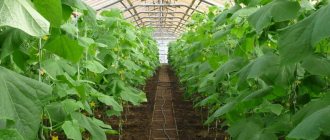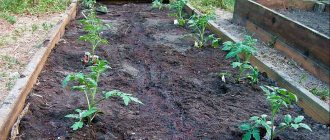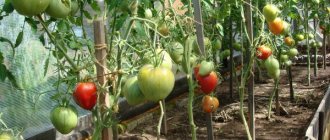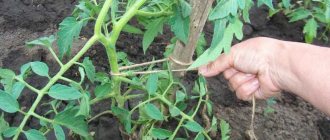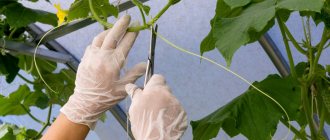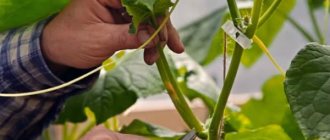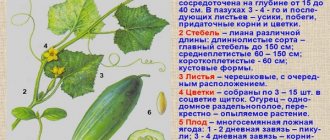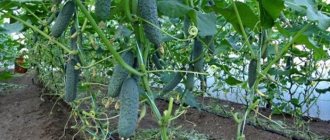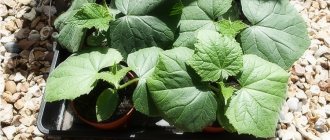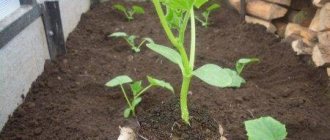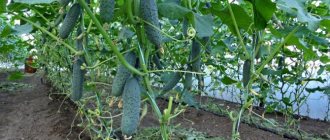Those who have collected greens in the open ground from plants that have been spread out know how their marketability decreases, especially after watering or rain. Dirty fruits are difficult to wash and dangerous to preserve - they may contain the causative agent of botulism, which cannot be destroyed by sterilization. It is not easy to find greens in dense thickets. If a cucumber overgrows, it draws on the plant's strength and the ripening of the remaining fruits slows down. Gartering cucumbers in open ground will help solve the problem. It will require additional labor, but is well worth it. And the point here is not only in the purity of the fruit.
Why do cucumbers need a garter?
You can do nothing at all, letting the vegetable develop on its own. This will cause the lashes to spread across the ground. What are the positive aspects of manipulation and how to tie cucumbers without injuring the vegetable?
Why tie up cucumbers?
The cucumber tying system is important for obtaining a high yield.
Why tie a cucumber:
- due to the support, the bush is formed correctly;
- a neatly formed plant is easier to plant;
- the development of lateral shoots increases;
- air exchange increases;
- compact bushes are formed;
- watering the plant becomes easier;
- contact of diseased and healthy shoots is excluded;
- convenient to collect fruits.
Stems creeping along the ground quickly dry out or rot. If the bush itself begins to weave haphazardly in a vertical direction, untied vines may break off under the weight of the fruit.
Pros of using a growth support
- The plant is illuminated effectively. Flows of air, heat and sun rays maximize crop yields;
- The risks of disease disappear. There will be no connection of leaves or fruits with wet soil;
- The harvest will be larger due to the fact that the plant grows upward. The number of ovaries and fruits will increase;
- It will become easier to care for vegetables. Convenience of loosening and weeding is guaranteed;
- With a garter of cucumbers, harvesting vegetables will go faster. Fruits are easier to spot on a support than on the ground.
How to properly tie cucumbers
- Installation of the support should not be accompanied by damage to the root;
- As soon as the shoots grow to 0.2-0.3 m, agrotechnical measures can be implemented;
- You need to be very careful when tying the stem to the support. If excessive force is exerted, it may become deformed;
- Pinching of shoots should take place when they reach a mark of 2 meters;
- Tie only the main shoots. Overgrown ones should be removed;
- Strengthened support is the key to an effective garter. It must support the weight of the stem and leaves.
Modern garter methods
With the development of gardening, new methods of planting plants, as well as their maintenance and placement, appear. In addition to standard cucumber rows, try unusual options for gartering and planting.
"Cucumber Tree"
The method got its name from its unusual appearance: adult bushes in such a garter resemble the crown of a tree strewn with cucumbers.
- Form a square bed to collect the cucumber tree. Reinforce it with wide boards on four sides.
- Plant the seedlings along the edges inside the square, placing the bushes at a distance of 30-35 cm from each other.
- Take four supports made of wood or metal, sink them into the ground at the corners of the square so that they are connected at the center by their upper ends.
- Fasten the upper ends of the supports with wire, fixing their position.
- Along the entire perimeter of the resulting structure, stretch rows of ropes to which the bush will cling. Place the ropes 30-35 cm apart.
This method is aesthetically pleasing, but requires a lot of time, as well as a large amount of space for a small number of bushes. Convenience lies in reusable use. Install a high-quality and durable structure, paying attention to details and fastenings, then it will last for several years.
Ropes will need to be replaced every season. If desired, you can use a special mesh, then it is not necessary to remove it in the fall.
Barrel method
The method is well suited in conditions of limited space. You can install a container with a plant anywhere on the site; it does not take up much space.
If you use a tall and large barrel, it will serve as both a container and a garter. Place a barrel, fill it with soil, plant 3-4 bushes, depending on the diameter.
In this case, tying up is not necessary; the cucumber vines will fall down the barrel and bear fruit normally.
Read about how to plant and grow cucumbers in a barrel in the next article.
A similar method can be used using buckets or small flasks.
- Place a container under a tree and plant 1-2 bushes in it.
- To assemble the weaving support, anchor the end of a strong rope into the ground next to the stem, then thread it through the tree branch.
- Secure the lower end of the rope next to the stem of another bush so that the structure looks like the letter “L”.
For this method, you do not need to tie the lashes yourself; they will stretch along a vertical rope and grow on their own.
Natural trellis
A method that does not require cost or much labor. Its essence lies in planting bushes along the fence of the site - a fence or mesh. The bushes are planted 20-25 cm from the beginning of the fence, and next to them oblique ropes are stretched to the top of the fence.
The weaving of the bush begins with a cord, and by the end of its growth it covers almost the entire hedge, like grapes. The only drawback here is the need to clear the hedge of dried lashes in the fall.
Hybrid method
An interesting design option in which trellises are driven in on three sides, forming a triangle. The upper ends of the supports are connected, the final structure looks like a pyramid.
- Install supports on three sides at a convenient distance. For installation, you can use both metal and wooden supports.
- Connect the upper parts of the supports with wire or secure with nails.
- Stretch ropes or mesh between the supports and secure the fabric with wire.
Because the climbing frame is at an angle, it is easy for the bush to curl upward and reach new levels. This method is suitable for small beds of two or three bushes, or for a new type of planting cucumbers - a circular bed.
To learn how to make a trellis for cucumbers with your own hands, see the following video:
Application of plastic bottles
The method does not describe the design of the support, but the option of attaching the stem to a base or rope. A plastic bottle is cut into strips, then the stem of the bush and the main rope are wrapped around it. The plastic tape is fastened with a stapler, forming a loose “collar” around the stem.
The disadvantage of this method is plastic. It has thin and sharp edges; such tying can cut the stem when bending it. Plastic also pollutes the soil; if such a structure is lost, it will remain in the ground for many years.
Tying under arches
The simplest method for low varieties of cucumbers is to install metal arcs over the bushes. The bent rods are dug into the ground so that the top point of the arc is at a height of 35-40 cm.
The bushes are initially tied to the arches, and then the lashes independently grow horizontally along the upper supports of the rods. The method is convenient for varieties with average climbing and growth.
The inconvenience of this method lies in the compactness of the weaving. Bushes can mix with each other, which makes it difficult not only to care for them and access light, but also to harvest.
Tying to ladders and arches
The method got its name for its visual similarity to a staircase or arch. The complexity of manufacturing lies in the cost of acquisition and assembly time. This garter looks nice and will last for many years.
- Select and purchase a garden arch or a structure similar to a folding staircase from a country store. Typically, such devices are used for decorative weaving of grapevines, but cucumber vines also do an excellent job with this function.
- Install the structure on the site, prepare the soil around it. Bushes can be planted on one side of the arch or on both.
- After planting, periodically throw the lashes of the bush over a new level, it will secure itself.
This method is more of an aesthetic nature, the structure is large, and few bushes are used. Therefore, this option is suitable for large areas without the need to save space.
Pyramid tying
This type is similar to the “cucumber tree” garter, it differs in the formation of ridges and the method of planting. As the cucumber vines grow, they will stretch along the canvas on their own and form a nice “Christmas tree” of bushes.
- To create a pyramid, choose a planting site, place several wooden or metal sticks in the ground, placing them in a circle.
- The upper ends must be connected with thick wire to form a conical pyramid.
- Stretch the ropes across the bars in several levels.
- Plant bushes around the pyramid from the outside; there is no need to strengthen the structure with boards.
The only inconvenience of this method is the low accessibility of the inner part of the pyramid. If the lash with fruits begins to grow inward and becomes entrenched there, it will be difficult to remove it.
Garter of cucumbers on pegs
For those who choose low-growing cucumber varieties, a simple garter method is quite suitable. Wooden pegs are installed next to each bush. The height of the stake should reach the maximum growth of the plant's vines.
The garter is carried out along the main trunk, attaching it to a peg. The remaining lashes are also placed on a support, tied at a short distance with a strip of fabric.
Garter methods
There are several types of this procedure, and each gardener chooses the method of tying cucumbers, based on the availability of equipment and capabilities.
- Single-row gartering of cucumbers in open ground or a greenhouse means that for each row, located in the range of 30-35 m, one support is provided;
- Double-row - a method in which support is calculated for two border rows. The garters are placed at an angle;
- Individual means that each lash gets support. A stick or post is suitable for this purpose. The method is suitable for both cucumbers and tomatoes.
Agronomists like vertical growth placement because of the space savings. You can place many bushes on a small piece of land. Horizontal is suitable for varieties with a low probability of lateral branching.
DIY metal trellises for cucumbers: photo of supports for cucumbers
To create a metal support, you will need certain tools and materials that need to be prepared in advance:
- two metal pipes or pillars, the length of which should be 2 m;
- one metal tube required for the crossbar, with a length equal to the length of the cucumber beds;
Often a metal mesh fence is used as a support for cucumbers.
- metal stakes, their number depends on the size of the bed;
- roulette;
- twine or twine;
- knife;
- electric welding;
- electrodes;
- hammer;
- shovel;
- steel wire.
Creating a metal support for growing cucumbers consists of several main steps. First of all, you need to dig two pillars into the ground along the edges of the cucumber bed. The depth of installation of the support should be approximately 40 cm. This value makes it possible to guarantee the reliability and stability of the trellis. Gardeners recommend hitting the post with a hammer several times to firmly drive it into the soil. Next, you should fill the hole and thoroughly compact the soil around it. After this, you need to secure the crossbar using electric welding.
Then you need to install a pair of pegs at a distance of 15-20 cm on both sides of the bed. After this, we stretch the twine or twine - they will be the reliable support along which the bush sprouts will begin to curl. We tie the end of a coil of rope to the first peg. Next, we pull the twine vertically up to the crossbar, wrap it around and lower it vertically down, tie it to a stake on the other side of the bed.
Craftsmen have created many designs for trellises for cucumbers.
We repeat the procedure until we have tied all the installed pegs. As a result, we get a trellis for cucumbers in the shape of the letter “L”.
A metal support made by yourself has a significant drawback: it is susceptible to rust. This can be corrected by covering the product in several layers with a high-quality primer or other anti-corrosion agent.
In addition, the disadvantages of this type of trellis include the inability to disassemble the structure at the end of the season. To move it to another part of the bed, you will have to dig up metal pipes, and after that you will need to re-dig the supports or columns into the ground.
On a note! Instead of twine or twine, you can use steel wire. It needs to be secured to the pegs and crossbar. After the cucumber shoots completely weave around the trellis, it will look like a green tent or hut.
Horizontal tying
The first stage is digging in two pillars made of wooden beams or metal. They are placed at the ends of the beds. The twine is installed so that it is between the supports.
It is necessary to maintain a distance of 25-30 cm. Next, the stems are fixed to the lower string. Then the levels above are affected. With this step, the shoot is able to wrap around the rope.
The lashes that gardeners are not happy with are shortened, as this is an important step in tying cucumbers in open ground and greenhouses.
Thus, the sun's rays will reach the plant without difficulty. The method requires regular adjustment of the mustache, which helps the growth of cucumbers. A vegetable cannot cope on its own.
How to properly tie cucumbers - step-by-step instructions
Compliance with the rules of tying increases the productivity of the plant and improves the quality of the harvest.
Important! Tying begins when the plant has reached 30 cm in height and has at least four true leaves.
Features of tying a cucumber:
- use soft cotton fabric so as not to damage the shoot;
- the binding loop should not be tight, otherwise the stem will break;
- control the process of bush formation and promptly guide the top around the support;
- do not tighten the ropes too much when tying vertically;
- overgrown bushes are tied up carefully so as not to damage the stem.
Failure to follow the rules leads to bush injuries that are not immediately noticeable. Subsequently, such a plant can become infected with a fungus.
In the open ground
Garter in open ground is especially important for plant development because:
- a tied bush throws out long shoots, on which more inflorescences appear and more fruits are set;
- a plant affected by a fungus or viral infection brings healthy shoots to the top, avoiding the spread of the disease;
- a vertically tied bush takes up less space on the site;
- It is more convenient to collect fruits without bending to the ground.
Without a garter, cucumbers in the open ground do not send out long shoots, thicken, rot and dry out, the stems break off under the weight of the harvest, and the fruits curl, wrinkle and lose their presentation and taste.
In a greenhouse, greenhouse
Reasons for tying a cucumber in a greenhouse:
- plants receive more sunlight;
- air exchange between bushes increases, and plants get sick less;
- lateral shoots are formed more actively, and the productivity of the bushes increases.
If traditional methods of tying are used in open ground, then in closed ground they use other methods.
Methods for forming a cucumber in closed ground:
- Blinding cucumbers. This method is based on the vertical garter method. The main stem is fixed on a support, and all side shoots and tendrils located above 50 cm from the ground are removed. Thus, the central stem is strengthened and fungal diseases are prevented.
- Formation in a polycarbonate greenhouse. The fabric is cut into strips of length equal to the height of the greenhouse. They are fixed to the metal profile of the structure. For each plant, tie a rope and guide the cucumber along it. In the same way, instead of ropes, they use long stakes, sticking them into the ground near the bushes.
Applying a grid
On the shelves of specialized stores you can find large-mesh plastic mesh. Cucumbers are actively climbing, and the mesh will do its job perfectly.
Just like twine, the mesh is pulled through 2 posts. Sagging from the weight of the seedling is eliminated with additional fastenings. The antennae, clinging to the support, calmly curl along the mesh.
The design is possible using wooden slats or wire. It is one of the most common ways to properly garter cucumbers.
Trellis net for cucumbers: features of plant garter
You can buy nets for such a trellis for cucumbers at any store. They easily replace both vertical and horizontal garters. Climbing nets allow cucumbers to grow freely in the cells. In addition, mesh trellises can be designed using any method: stretched between two posts, the frame made in the form of a triangle, rectangle, or the beds can be placed on the site in another convenient way.
A trellis net for cucumbers is a popular and inexpensive option available to every gardener.
The trellis structure consists of support posts and mesh. Racks can be made of metal pipes, wooden blocks or concrete posts. To form a mesh weave, you can use rope, hemp twine or wire. Currently, a special plastic mesh for trellises is especially popular. This recognition is explained by the ease of installation and availability of the material.
To install the structure, just buy a trellis for cucumbers in an online store and secure it with wire on the top of the posts. The lower edge of the support must be deepened into the ground and secured with special wire hooks.
This trellis is made and installed quite quickly and looks attractive. In addition, it is not difficult to make a trellis for tomatoes and cucumbers with your own hands.
Pyramid
Often used by agronomists when planting vegetables. How to build it and effectively tie up cucumbers in the garden?
- Cucumbers grow in a circle and a distance of 1.5–1.8 m is maintained. There is a long pole in the middle of the circle. The quality of the crop is not affected by the support material. You can choose metal or wood;
- Each bush gets its own peg;
- Forming a pyramid involves tying the stems with ropes. Garters are attached at an angle of 65-70 degrees.
You can adjust the materials to suit yourself, replacing them with long sticks or rods. Digging of handrails is done in a circle. They should be connected in the center. The ropes are hung in several tiers. The garter mechanism is similar to a hut. The structure will definitely attract the attention of others.
Wooden support for gartering cucumbers in a summer cottage
Creating a structure made of wood is considered the simplest way and is perfect even for novice gardeners who have decided to grow cucumbers using a support for the first time.
To create such a trellis you will need:
- three bars about 2.7 m long;
- plank measuring 5 m;
- steel wire;
Wooden trellises are quite popular among garden owners.
- three wooden crossbars 0.8 m long;
- twine;
- hammer;
- nails;
- shovel.
To make a wooden trellis with your own hands, you need to follow these steps:
- Prepare the place where the wooden supports will be installed.
- You should dig three holes 80 cm deep at a distance of about 2.5 m from each other.
- You need to insert wooden blocks into the prepared holes and carefully bury them in the ground.
- After this, a crossbar must be nailed to the top of each block so that the structure resembles the letter “T”. There should be three such supports. They should be placed one after another in the garden bed.
- Next, all three structures need to be connected in the middle. To do this you will need nails and a long spacer bar.
- After this, you need to tighten the steel wire using nails.
- Cut the twine into equal pieces (their length should be approximately 250 cm). We tie one end to the wire, and tie the cucumber stems with the other.
The reliability and durability of the trellis structure depends on the material and installation method - there are both temporary and permanent options.
The technique of growing fruit crops using trellises is very convenient and effective. Plants placed and secured vertically take up significantly less space in the garden and rarely break.
Translated from French, the word “trellis” means “shoulder” or “support.” At first, such support structures were used exclusively for decorative purposes for flowering crops. Over time, trellises began to be used in agriculture. Photos of do-it-yourself trellises for peas, cucumbers, tomatoes and other crops can be found on the Internet with a detailed description of their creation.
Lack of garter in open ground
Cucumbers can grow without outside support. During the method, a cucumber carpet appears on the ground. It is necessary to prevent the stems and tendrils from becoming tangled on the ground. Varieties pollinated by bees are carefully pinched.
Trellis mesh
The mesh is more aesthetically pleasing than the previous two methods. It is very comfortable for both humans and cucumber bushes. The mesh fabric is purchased at a gardening store. Naturally, you first need to measure the length of each bed of cucumbers in order to purchase a sufficient amount of this material.
To attach it you will need two beams or pipes. Stretch a mesh between two adjacent bases. Secure around the entire perimeter with wire. Attention! Not close to the stems. Otherwise, you can cause serious damage to the bush.
Caring for cucumbers without tying them up
The stem should be shortened after 4-5 leaves. If this is not done, growth will occur uncontrollably and the plant will not produce normal fruits due to exhaustion.
The sides need to be pinched over the second sheet. Pinching will speed up the formation of female flowers in cucumbers. The ovaries will appear.
Required materials and tools
You can easily find everything you need for tying cucumbers on your site:
- Wooden beams, logs. You need to take hardwood. It is also important to treat them with an antiseptic before burying them in the ground. Installation depth - no less than 0.6 m.
- Metal pipes. To protect them from corrosion, they are coated with oil paint and special products. When installing, use a garden drill to make a hole up to 0.5 m. Then drive it a little into the soil, about another 20 cm. The voids around the post are filled with earth and compacted.
- Cement pillars. It is necessary to use formwork and build it in stages, so their use is practically not practiced.
- Twine or twine.
- Fabric cut into shreds.
- Carnations.
- Low wooden pegs.
- Pliers and hammer.
If you plan to hang the whips on a mesh (lattice), you can purchase it for little money at a socialized store. Hooks for securing the vines in the cell are additionally purchased there.
Trellis method
Important! You should not use thin wire for tying; it can cut the delicate stems of the shoots.
Formation of cucumber bushes
The importance of correct formation of bushes is on par with tying. Energy should be aimed at the appearance of fruits, and not at survival.
This event is carried out at the stage of fixing the stem to the support. It consists of removing the stepsons after the appearance of 3-4 leaves, pinching the side shoots during the period of growth to the trellis.
When the top mark of the trellis is reached, the shoots are moved from the wire and growth is frozen by pinching.
Unusual methods
Cucumber lovers from all over the world continue to modernize old and well-known garter methods and, at the same time, develop new, original ways of forming a cucumber bush.
Cucumbers in a barrel
The basis of the design is a barrel. Plants are planted in a container filled with soil. Due to the force of gravity, as they grow, the shoots begin to hang over the edges and grow vertically downwards. This method saves space on the site.
cucumber tree
The basis of tying is to form a bush into several shoots in such a way that it becomes like a tree . To do this, build a structure with horizontal crossbars. A rope is attached to it, which will connect the main stem and the crossbar. Ropes are also attached to the side lashes and spread to the sides. After the formation of female ovaries, the side stems are carefully brought to the main one. The angle between the central and side shoots is left at 60°, so the plant is not injured. The tendril from the central shoot is wrapped around the side shoot, and the remaining shoots are removed.
Plastic bottles
In this method, a plastic bottle is used to secure the cucumber stem to the structure. The bottle is cut into strips of the required size. A strip is wrapped around the stem and the structure at the attachment point, and the ends of the plastic are connected with a stapler.
Natural trellis
The fence serves as the basis for tying. Plants are planted along the structure, and if it is a chain-link, just point the cucumber, and it will begin to weave around the mesh itself. And if the fence is wooden or metal, string ropes from the top edge to the base of the bushes, and the cucumbers begin to weave around them.
Expert advice
Based on their mistakes, agronomists want to share their example. This will help novice gardeners avoid failure.
Developing independently, the bush develops randomly. Its side shoots can interfere with the stem and prevent it from growing. Consider the following nuances of the garter:
- Each side escape must be directed along a personal rope;
- Growing a bush more than 1.5 meters on a trellis will not be crowned with fruitful success. The leaves on top will shade the ones below. Pinch the top as you go to stop growth;
- Choose the garter material based on the structure;
- The horizontal method is preferable to the vertical one if you do not want to spend a lot of money on support;
Morning time is the most optimal time for tying. The plant will be able to recover before the temperature rises in the afternoon.
Tying cucumbers greatly facilitates the growth process. There are many ways to improve productivity and crop development. Everyone has the right to choose the type of garter they like. Thanks to the imagination of gardeners, the growth of cucumbers can improve the design of the site.
Linear designs for cucumbers
The linear type is ideal if there is little space in the garden bed and you want to plant a large number of cucumbers. Such structures can be installed almost end-to-end. Just don’t forget about the passage between the rows of plants.
Please note that jute ropes and synthetic cords cannot be used. You will damage the trunk, branches and leaves of the bush. It is better to cut strips from old and rather soft fabric. The length is from 1.5 to 2 cm wide.
Photo of the correct cucumber garter
Mistakes you shouldn’t make when tying cucumbers in a greenhouse
Some novice gardeners make a number of common mistakes when tying cucumbers:
- Extended deadlines. The taller the plant becomes, the more difficult it is to tie it to a support, since the stem becomes rigid and bends poorly. Recommended planting length to start with
- Violation of the growth direction rule. Since ancient times, it has been believed that all plants grow and move strictly clockwise. If you start twisting the stem around the support counterclockwise, the plant will not grow well.
- The stem is too tight. If the loop or clamps are located too close to the vine, they can overtighten them, which will disrupt proper growth and lead to the death of the plantings.
- Choosing the wrong materials for tying. It is better not to use wire and hard metal clamps in your work. This can cause injury to the bush and interfere with normal growth.
- Untimely twisting of the escape. It is necessary to help the bush form correctly and direct the shoot clockwise towards the support. For additional reliability, it is tied to it with pieces of fabric.
Why is tying necessary?
Cucumbers are annual crops of the pumpkin family that have a pentagonal stem and resemble a vine in appearance. By means of its tendrils, the plant spreads along the ground or clings to a nearby surface. It is light- and moisture-loving. In just one season, the bush produces a considerable amount of greenery, actively absorbing nutrients contained in the soil.
The easiest way to grow a good harvest of this vegetable is in a greenhouse, where it is much easier to create the necessary conditions for it. A garter is needed so as not to lose some of the fruit even at the stage of ovary formation.
If a bush spreads along the surface of the soil, it usually does not have enough light. At the same time, the buds begin to crumble, and the fruits lying on the ground are exposed to insect pests and begin to rot.
If we specifically talk about cucumbers grown in a greenhouse, tying is necessary here for the same reasons:
- The vegetable gets more light.
- It retains a greater number of ovaries.
- The whiskers do not cling to neighboring bushes.
- Easier to harvest.
Many people have a question: how to tie cucumbers in a polycarbonate greenhouse? Experienced gardeners tie up the stem when it grows to 30 cm. At this moment, it already has 4-5 leaves. If the garter is carried out later, care must be taken not to accidentally injure the stem.
